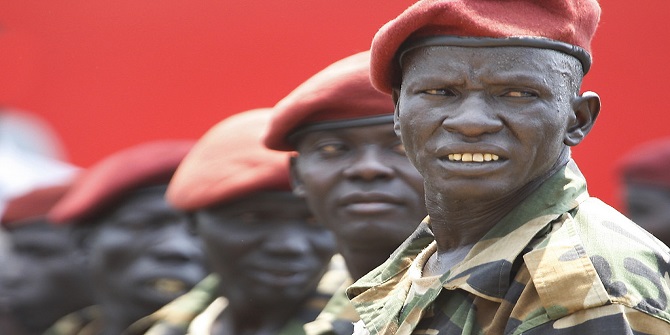
Presidential Guard, South Sudan. Source: Flickr Antheap 2011.
In South Sudan’s political marketplace, a bad peace deal—or a badly-implemented peace deal—can be as bad as no deal at all. A collapsing peace deal has the potential of unleashing exceptionally severe violence.
According to the ‘do no harm’ precept, those who design peace agreements and steer their implementation, should not allow optimism of the will to befog their analytical lenses. We must always read the politicking around implementing a peace deal with the default supposition that the deal may collapse and violence may break out again.
So it is with the security provisions of the Revitalized Agreement on the Resolution of the Conflict in South Sudan (R-ARCISS).
The agreement, constructed by two masters of the regional political marketplace—President Omar al Bashir of Sudan and President Yoweri Museveni of Uganda—is an intricate division of the spoils. Central to it is a ‘payroll peace’: specifically, provisions that allow the warring parties to put hundreds of thousands of men into military cantonment sites where they will be organised, fed, housed and perhaps paid or provided with packages for disarmament, demobilisation and reintegration.
As outlined in the recent CRP memo on South Sudan, The Perils of Payroll Peace this is a recipe for the parties to mobilise soldiers and organise them, making any breakdown in the peace process even more dangerous. This error has been made time and again—it’s time to learn the lesson that the security arrangements provisions in a peace deal should not be designed so as to create perverse incentives for organising military units.
The plan to organise a ‘unified force’, comprising troops from government and opposition, poses an even greater hazard. Senior government officials are on the record insisting that creating such a unified force is a precondition for forming the transitional government.
South Sudan and Sudan have a well-documented history that attempts to unify, integrate or absorb forces into a single national army are extraordinarily complicated, fraught and long-winded. Despite the public avowals of political leaders, they always maintain a powerful reserve of loyal troops to secure their own position, should circumstances change. Only the weakest allow their forces to be integrated.
This is a worldwide phenomenon: in a comprehensive review of post-civil war military integration, Ronald Krebs and Roy Licklider come to the simple conclusion: don’t! Despite the ubiquity of provisions for integrating government and rebel forces after conflict, there’s no systematic evidence that it works to reduce the risks of future conflict, and much evidence to the contrary.
Crisis Group has warned against this too, proposing instead ‘a small, limited-mandate third-party protection force for opposition leaders, the least objectionable of bad options for Juba’s security arrangements.’
In South Sudan’s political marketplace, turmoil and unpredictability are the norm. A peace agreement shouldn’t be envisaged as a proto-constitution, a once-in-a-generation reformulation of the nation’s political settlement. Rather, it’s a bargain in a bazaar, good for as long as those market conditions hold.
At best, a peace agreement needs constant renegotiation to keep it alive—in mediation parlance, space for implementation protocols and appendices. At worst it is a breathing space in which the parties prepare for a likely new war. Accepting this, we can surely design peace deals to maximize the opportunities for adaptive renegotiation and to minimize the risks of catastrophic violence should they falter.
Despite the ubiquity of provisions for integrating government and rebel forces after conflict, there’s no systematic evidence that it works to reduce the risks of future conflict, and much evidence to the contrary.
Note: The CRP blogs gives the views of the author, not the position of the Conflict Research Programme, the London School of Economics and Political Science, or the UK Government.





1 Comments